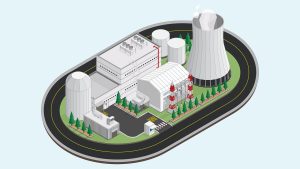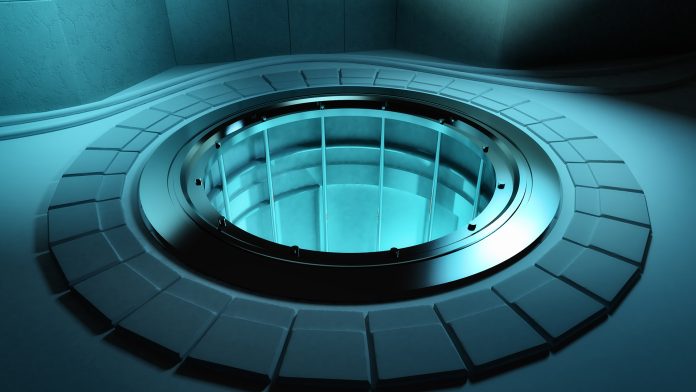Work performed within the ANItA project identifies SMR designs suitable for electricity production in Sweden and points out the need for further research.
In one of the ongoing initial projects within ANItA, a Swedish national competence centre for nuclear power technology, work is performed to identify small modular nuclear reactor (SMR) designs that are suitable for Sweden’s electricity generation in the relatively near future. The aim is, furthermore, to point out novelties compared with the current Swedish reactor fleet that might need further investigation.
Suitable SMR designs
SMRs are considered an option for adding new nuclear capacity in Sweden. The SMRs can be used for different purposes. In addition to electricity generation, the heat produced can be used for district heating to heat homes and commercial buildings or be supplied to various industrial processes, including hydrogen production. All these applications are investigated within ANItA.
Various types of SMRs have been proposed, some based on the technology of current nuclear reactors and others intended for use in future Generation IV nuclear power systems. The types based on the technology of existing nuclear reactors usually belong to the classification known as Generation III+ reactors. Design descriptions of many, but not all, proposed SMRs have been compiled by IAEA.¹
As the name suggests, SMRs differ from large-scale reactors in that they are smaller and more modular. This means that they have a smaller physical size as well as power output and, to a larger extent, will be built using pre-fabricated modules that will be assembled at the reactor construction site. These features imply potential advantages over large-scale reactors. The smaller size and output often make it easier to design reactors that are easier to operate and more easily can be used for other purposes than only electricity production. Importantly, the increased modularity also allows for shorter construction times.
There are currently six operable large-scale reactors in Sweden, and six permanently shut down. All of these started operation between 1972 and 1985 and are of the type light-water reactor, meaning that they use light-water (i.e. normal water) as coolant and to moderate the energy of the neutrons released in the fission process taking place in the nuclear fuel. The term light-water reactors is used to distinguish them from heavy-water reactors, which use heavy water instead (i.e. water enriched in the hydrogen isotope deuterium).
There are two main varieties of light-water reactors: boiling water reactors (BWRs) and pressurised water reactors (PWRs); both of these are used in Sweden. Light-water reactor technology is the most common reactor technology not only in Sweden but also worldwide.
As the legislation in Sweden is adapted to land-based (as opposed to marine-based) light-water reactors, it will, from a licensing perspective, be less of an effort to deploy this type of SMR compared with other types. Additionally, to be easily deployable, the design needs to be at an advanced stage. Furthermore, the SMR should be developed by an organisation that has the capability of delivering the reactor, and that is based in a country from which it is politically acceptable to acquire nuclear technology.
More than 25 land-based light-water SMR designs have been proposed. Of these, one BWR and four PWRs are used as reference designs in the work performed in this project. The five SMRs are (with the developing organisation within parentheses):
1. BWRX-300 (GE-Hitachi)
2. Rolls-Royce SMR (Rolls-Royce)
3. AP300TM (Westinghouse)
4. VOYGRTM (NuScale)
5. NUWARDTM (EDF)
Novelties in proposed SMR designs
In the proposed light-water SMR designs, there are several notable novel features compared with the current and previous Swedish reactors. Some of these features are or have been in use in other reactors outside Sweden, whereas some are novel to the world. Many of the novelties can be expected to lead to a simplified construction or operation of the reactors. However, before they can be employed in a real reactor, it is necessary that the novelties are well understood from a technical perspective and that there are no regulatory hurdles to implement them.

Notable novel features of the proposed SMR designs compared with the current and previous Swedish reactors, apart from the smaller size and increased modular construction, include:
• Enhanced use of natural circulation
• Increased passive safety
• Novel reactor containment designs
• Integral PWR designs
• Novel types of water chemistry
• Having several reactors located in a common reactor building and controlled from a common control room
• Increased load-following capability
• Dry storage of used nuclear fuel
Natural circulation means that no pumps are used to circulate the reactor coolant. It allows for a simplified reactor design and operation with fewer components and less maintenance need. Additionally, it allows for increased safety, not relying on the pumps.
Passive safety, such that no operator action, external supply of electricity, or other auxiliary systems are needed to keep the reactor core cooled for three days or longer, is implemented in the SMR designs. Passive safety is, to a large extent, enabled by the use of natural circulation. Other features enabling passive safety include gravity and pressurised systems.
The reactor containment is a structure that has the function of containing radioactivity in case of an accident. All Swedish reactors have containments made of pre-stressed concrete, whereas the SMR designs have containments made of steel or steel–concrete composite materials.
In integral PWR designs, some of the main components, e.g., steam generators, drive mechanisms for control rods, and pressuriser, are located inside the reactor pressure vessel. Integral PWRs are much more compact than normal PWRs and the reactor is designed to be delivered as one unit that is connected to the non-nuclear parts of the power plant.
The most notable novelty in water chemistry is the proposed use of boron-free PWR coolant in some SMRs. Boron is used in current PWRs to control the reactivity, i.e., the rate of the fission process. Some other novel types of water chemistry are also proposed. Water chemistry needs to be optimised to keep material degradation at a minimum. This is essential for the long-term operation of the reactors.
Having several small reactors located in one common reactor building and controlled from one common control room can be efficient from the perspectives of construction and operation. The single control room makes it possible to operate the reactors using less staff.
Load-following capability is the capability of adjusting the electrical output to the grid depending on the demand for electricity. To some extent, this flexibility already exists in current reactors. There are two main ways of load-following, one being to reduce the reactor power when the electricity demand decreases and the other to maintain the reactor at maximum power and use the steam for purposes other than producing electricity, for example, to produce hydrogen or provide heat to other industrial processes.
The used nuclear fuel in Sweden is stored in water pools (so-called wet storage) at the interim storage facility Clab in Oskarshamn. Some SMR designs include dry storage of used fuel at the reactor site, as is done in several other countries. There are two major benefits of introducing dry storage in Sweden. Firstly, there will be no need to expand Clab or build a new wet-storage facility once its capacity is reached. Secondly, transportation of spent nuclear fuel will be less frequent. This could be especially beneficial if SMRs are deployed at new sites that are not connected to the current transportation infrastructure by sea.
Need for further investigation
Novel features can affect one or more of nuclear reactor licensing, construction, and operation. Maintenance of reactor components and management of radioactive waste are here considered part of the operation of the reactors.
All of the novelties listed above, as well as the smaller size and the increased use of modularity, can affect the licensing and operation of the SMRs. The smaller size, the increased use of modularity, and the new containment designs will also affect the construction of the power plants.
To successfully deploy SMRs in Sweden, it is important to address the potential barriers caused by the novel features. The novelties need to be well understood and their functionality proven, and they need to be permitted. There is thus a need for further investigation regarding technical features as well as the legislation concerning nuclear power. Additionally, the economic aspects of SMRs need to be considered. Some of the novelties and the corresponding potential barriers are the topics of other currently ongoing ANItA projects. Others are foreseen to be researched in future ANItA projects.
Summary and conclusions
SMRs are one option for adding new nuclear capacity to meet the future electricity demand in Sweden. Of the various SMR types proposed, light-water SMRs, i.e. reactors similar to but smaller and more modular than current large-scale reactors, are the most likely to be built in the relatively near future. Because of their similarities with current reactors, the proposed light-water SMRs should, for the most part, be rather straightforward to license, construct, and operate. However, there are some novel technical features in the proposed SMR designs that require further investigation for the successful deployment and operation of them in Sweden.
A report explaining the novel technical features and the need for investigation in more detail will be available at the ANItA website around the end of this year as this part of ANItA (Project A2) nears completion.
References
- Advances in Small Modular Reactor Technology Developments, IAEA, 2022, https://aris.iaea.org/Publications/SMR_booklet_2022.pdf
Please note, this article will also appear in the 19th edition of our quarterly publication.








